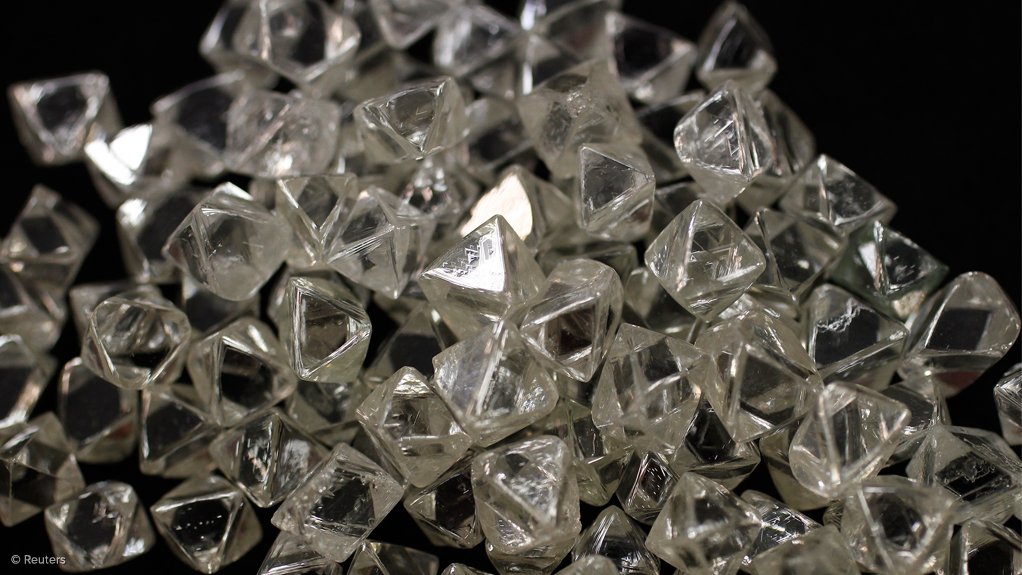TORONTO (miningweekly.com) – Despite efforts by diamond majors De Beers and Rio Tinto to curb global diamond supplies, lower output is forecast to be offset by stable Russian production, new mines, and production increases by Dominion Diamond Corp and Petra Diamonds, according to independent industry analyst and consultant Paul Zimnisky.
In a report published on Monday, Zimnisky stated that he expected 2016 global diamond production-by-volume to grow by 1.3% year-on-year to 137-million carats, despite De Beers and Rio's efforts.
However, the impact of strategic production cuts was more apparent on a value-produced basis, as curtailments at De Beers' high-value mines in particular, and lower diamond price offerings across the industry, reduced global diamond production-by-value forecasts by 10%, over 2015 estimates, to $12.6-billion in 2016.
The average price per carat was estimated to be $92 in 2016.
MAJORS
Zimnisky noted that industry leader De Beers, representing more than 30% of global market share, strategically reduced output at multiple mines in 2015 and completely suspended production at others, cutting total output by about 7% in 2015 to 29-million carats.
As tailings operations offer the greatest operating flexibility, De Beers strategically reduced tailings production at Orapa, in Botswana, last year before reducing production at Venetia, in South Africa, and offshore operations in Namibia. It also putt Snap Lake, in Canada, and Damtshaa, in Botswana, on care and maintenance in an effort to balance global diamond supply/demand.
De Beers also sold its South African Kimberley tailings mine and related operations in December for $7.2-million to a joint venture between Petra Diamonds and private firm Ekapa Mining.
De Beers was targeting 26-million to 28-million carats in 2016, compared with 29-million in 2015, and 33-million in 2014, less 6.9% and 18.2%, respectively.
While De Beers cut production, Russian miner Alrosa, which had a similar market share, increased output in 2015 by 6% year-on-year to 38-million carats. Instead of reducing production, Alrosa held back supply by only selling 78% of 2015 production.
Production at the company's largest mine, Jubilee, which represented about 25% of the company's output, increased 3.1% as higher grade was achieved at the orebody's central lobe. Production decreased at the company's second-largest mine, Nyurbinskaya, as the mine’s processing plant was shared with ore from the Botuobinskaya mine and the Nyurbinskaya placer operations.
Zimnisky said that Alrosa had indicated that it did not plan to reduce production unless market conditions got substantially worse. The company was targeting production growth going forward, with an average output of about 40-million carats a year being the norm over the next decade.
Rio Tinto’s ’s Argyle mine, in Australia – the world’s largest diamond mine by production volume – realised a bigger-than-45% year-on-year production increase in 2015, after completing a multiyear underground mine development project. This was despite strategically halting processing in December in an effort to “manage inventory levels” in a softer global diamond market. Argyle produced 13.5-million carats in 2015, compared with 9.2-million carats in 2014.
In June 2015, Rio sold its 78% stake in Murowa mine, in Zimbabwe, to partner with RioZim (private), which now owns 100% of the mine. A new diamond mining tax structure in Zimbabwe and concerns of forced government consolidation of the country’s diamond miners most likely influenced the company’s decision to leave the country, Zimnisky said.
Rio now only held two operating diamond mines, 100% of Argyle and 60% of Diavik, in Canada. The company was targeting 21-million carats in 2016.
Dominion Diamond is Rio’s 40/60 partner in the Diavik mine, which had four kimberlite pipes, three of which were in operation. The fourth pipe, A-21, had a 10-million-carat reserve and was being developed for $400-million, with first production slated for late 2018. In 2015, Diavik produced 6.4-million carats, which was down 11.5% year-on-year, owing to processing plant pauses in the fourth quarter and the absence of stockpiled ore, relative to 2014.
Dominion’s second asset, its 89%-owned Ekati mine, produced about three-million carats in 2015, a 6.3% decrease over 2014, as the company transitioned the mine plan to focus on the Misery Main pipe. Misery Main was a 14-million-carat reserve with first production expected in the first half this year. It was estimated to contribute four-million carats this year, which would substantially increase the mine’s output by 70% to an estimated 5.1-million carats in 2016.
Looking further ahead, Ekati’s Jay pipe, which was an 85-million-carat reserve, and was currently in the feasibility study stage, would come on line in 2020. The Pigeon pipe, a three-million-carat reserve (and ten-million-carat resource), which began production in 2015, would fill the mine’s production gap between Misery Main and Jay in 2018 and 2019.
Edited by: Samantha Herbst
Creamer Media Deputy Editor
EMAIL THIS ARTICLE SAVE THIS ARTICLE
To subscribe email subscriptions@creamermedia.co.za or click here
To advertise email advertising@creamermedia.co.za or click here













